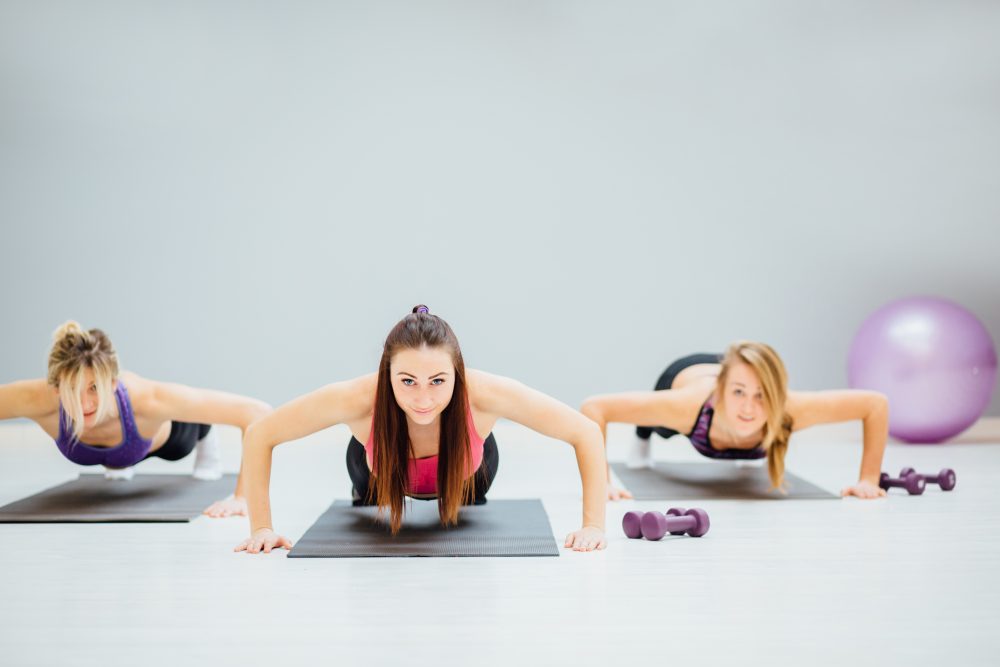Written by Angela Silva
When you change the way you think about exercise to a matter of functionality rather than physique, you start to realize the importance of some very basic moves you were taught at a young age.
Let’s think about it for a minute: what are some regular “exercises” that are part of your daily life?
- When you sit down on a chair, and then stand up again, there’s your squat.
- When you bend down to reach for the remote under the couch, there’s your pushup.
- When you reach to the top shelf to hide the chocolate you just bought, there’s your overhead press.
- When you’re late and run up the stairs 2 at a time, there’s your lunge.
Being able to do these basic movements, plus a few more, is very important to your functional life and even quality of life. You can probably think of several people you know, maybe even yourself, who suffer from lower back pain, knee pain, weak ankles, etc. The cause of a lot of these problems is often muscle compensation – your weak muscles are unable to perform the job they’re supposed to do, so a different muscle group takes over. This can wreak havoc on your entire “chain of command,” as far as which muscles are doing what, and cause pain and misalignment.
So let’s take a look at a few basic moves you should be able to do properly, and how to fix any compensations you may notice.
1. Basic overhead squat
Here are the steps to properly perform a basic overhead squat while checking for any imbalances and compensations:
- Raise arms overhead, so that your triceps align with your ears.
- Place feet hip-width apart, parallel, with your toes pointed forward.
- Sit back as if sitting in a chair, maintaining a neutral spine, and ensuring your knees don’t extend beyond your toes.
What to look for:
At the bottom of the squat, your arms should form a straight line from the fingers, to the shoulders, down to your hips.
- If your arms fall forward, this could be a sign of shoulder instability and weakness.
- If your back arches, this could be a sign of glute and core weakness and instability.
- If your knees move inward toward each other, this could also signify weak glutes.
2. Push-up
Here are the steps to performing a standard push-up while checking for any imbalances and compensations:
- Start on your hands in knees, with your hands directly underneath your shoulders.
- Keep your back straight and your core tight.
- Lift off onto your toes.
- Bend your elbows to lower yourself until your arms are bent to a 90-degree angle.
- Your chest should be just a few inches off the ground before you extend your arms, raising your back up.
What to look for:
- If you can’t bend your arms to a 90-degree angle, this could be a sign of muscle weakness in your biceps, triceps, shoulders, and chest.
- If your back arches with your glutes in the air, this could be a sign of core weakness or lack of core and glute engagement.
3. Lunge
Here are the steps to properly performing a standard forward lunge while checking for any imbalances and compensations:
- Begin by standing straight with legs hip-width apart, back straight, shoulders back.
- Take a big step forward with one leg, bending both your front and back knees to 90 degrees.
- Maintain a straight back and engaged core.
- Push back with the extended leg to return to standing position.
- Repeat with the other leg.
What to look for:
- If your torso falls forward, this could be a sign of weak core and glute muscles.
- If you aren’t able to bend to 90 degrees, you may need to take a bigger step forward or work on high hamstring flexibility.
4. Plank
Here are the steps to perform a standard plank while checking for any imbalances and compensations:
- From your knees, walk your hands forward until you’re in a modified push-up position.
- Lower yourself onto your elbows and forearms, with elbows directly under your shoulders.
- Lift your knees off the ground, engaging your core and keeping your back straight.
- Hold this position for 30 seconds, or until failure.
What to look for:
- If your hips sag, this could be a sign of core weakness.
- If your hips raise, this could also be a sign of core weakness.
5. Overhead press
Here are the steps to properly perform a standard overhead press while checking for any imbalances and compensations:
- Choose a dumbbell weight with which you could perform 8–12 reps before failure.
- Hold a dumbbell in each hand, facing each other at shoulder-height.
- Slightly bend your knees and keep your spine neutral.
- Press the weights over your head until your arms are fully extended.
- Your arms should be next to your ears as you hold slightly at the top before lowering back down to your shoulders.
What to look for:
- If your arms fall forward rather than extend straight overhead, you have weakness and inflexibility in your shoulders.
- If your back arches as you lift overhead, this could mean your core is weak or your hip flexors are too tight to maintain alignment over your knees.




No Comment